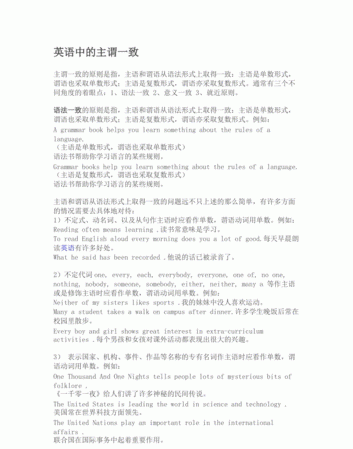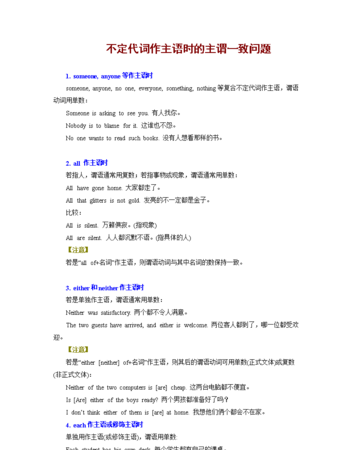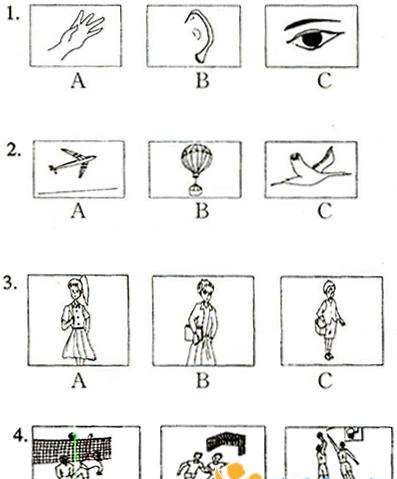本文目录
主谓一致语法总结
看前面的。
例:The teacher as well as the students is friendly.
谓语is与前面的主语teacher一致。

定语从句中主谓一致的例句
一般情况下,主谓之间的一致关系由以下三个原则的支配: 语法一致原则、 意义一致原则和就近原则。
一、语法一致
主谓一致的原则是指主语和谓语从语法形式上取得一致:主语是单数形式,谓语也采取单数形式;主语是复数形式,谓语亦采取复数形式。例如:
He often helps me learn English. (主语是单数形式,谓语也采取单数形式) 。
My friends often help me learn English. (主语是复数形式,谓语也采取复数形式)
但主语和谓语从语法形式上取得一致的问题远不只上述的那么简单,有许多方面的情况需要去具体地对待:
1、不定式,动名词,以及从句作主语时应看作单数,谓语动词用单数。
例如:Reading aloud is helpful to learn English.大声朗读对学习英语是有帮助的。
What he said has been recorded .他说的话已被录音了。
2、不定代词one, every, each, everybody, everyone, one of, no one, nothing, nobody, someone, somebody, either, neither, many a 等作主语或是修饰主语时应看作单数,谓语动词用单数。但none 作主语时,谓语动词既可用单数也可用复数,这要取决于说话人的看法。
例如:Neither of my sisters likes sports .我的妹妹中没人喜欢运动。
Every boy and girl shows great interest in this book .每个男孩和女孩对这本书都表现出很大的兴趣。
3、表示国家,机构,事件,作品等名称的专有名词作主语时应看作单数,谓语动词用单数。
例如:One Thousand And One Nights tells people lots of interesting stories . 《一千零一夜》给人们讲了许多有趣的故事。
4、a kind of, the number of等与名词构成名词短语作主语时应看作单数,谓语动词用单数。
例如:The number of workers in the factory is 400. 这个工厂里工人的数量是400.
A kind of rose in the garden smells very pleasant.这座花园里有一种玫瑰香气怡人。
5、由some, several, both, few, many, a number of 等词修饰主语,或是由它们自身作主语时应看作复数,谓语动词用复数。另外,由and连接两个主语时,谓语一般用复数。
例如:On the seashore, some people are playing volleyball 海边,有些人在打排球。
Both of us are fond of watching football games .我们俩都喜欢看足球赛。
A number of will-be graduates are voluntarily going to work in the West of China. 许多即将毕业的学生打算自愿去中国西部工作。
6、有些表示数量的百分数,分数等后面加名词或代词作主语时,要根据这个名词或代词来决定其谓语动词的单复数形式。如:a lot of, most of, any of, half of, three fifths of, eighty percent of, some of, none of, the rest of , all of等后接不可数名词,或是单数形式的名词作主语时应看作单数,谓语动词用单数;但如果后接可数名词的复数形式作主语时应看作复数,谓语动词用复数。
例如:A lot of money in the shop was stolen yesterday. 昨天那家商店丢失了许多钱。
A lot of students are from England in the school.那个学校里很多学生来自英国。
二、意义一致
这一原则是指,从意义着眼来解决主谓一致问题。有时主语形式上为单数,但意义上却是复数,那么谓语依意义也用复数形式;而有时主语形式上为复数,但意义上却是单数,那么谓语依意义亦用单数形式。
1)当主语后面接由but, except, besides, as well as, as much as, including, more than, no less than, rather than, together with等引导的词组时,其谓语动词的单复数形式通常由前面的词来决定。在这样的句子里,这些词所引导的词组不影响主语自身的单,复数形式,它们在句子里其实是状语。
例如:The teacher, with all his students, is going to have a picnic this weekend.老师打算这个周末与学生们一起去野炊。
The students, together with their teacher, are going to have a picnic this weekend.学生们打算这个周末与他们的老师一起去野炊。
我们完全可以将上面句子中的那些词组都分别搬到句首或是放到句末去,因为它们在句子里是状语:The students are going to have a picnic this weekend together with their teacher.
2)表示时间,金钱,距离,体积,重量,面积,数字等词语作主语时,谓语动词常用单数形式。如:
Eight hours of sleep is enough. 八小时的睡眠足够了。
Twenty years stands for a long period in one's life. 二十年在人的一生里意味着一个很长的时期。
3)形容词前加定冠词即“the + 形容词”作主语时,其意义若是指个人或是抽象概念应看作单数,谓语动词用单数;指一类人则应该看作是复数,那么谓语动词也应该用复数。
例如:The sick here are very well cared for. 这里的病人都被照顾得很好。
The true is to be distinguished from the false. 真实与虚假应加以区别。
4)由and 连接的两个单数名词作主语时,谓语动词一般根据语法一致的原则用复数。
但如果在意义上指同一个人、同一件事或同一个概念时,谓语动词要用单数形式。
如:The writer and teacher is coming. 那位作家兼教师来了。(作家和教师指同一个人)
The writer and the teacher are coming. 作家和老师来了。(作家和老师是两个人)
5)集体名词作主语时,谓语动词的数取决于主语的意义:主语表示整体时视为单数,谓语动词用单数;主语表示集体中的个体成员时视为复数,谓语动词用复数。这类集体名词常见的有:army, class, club, crowd, family, government, group, people, police, public, team等。
例如:The family are all fond of football. 那一家人都喜欢足球。
The family is the tiniest cell of the society. 家庭是社会的最小的细胞。
6)一些形式为复数,意思为单数的名词,如:trousers, pants, shorts, glasses, 等作主语时,谓语动词用复数。
如:Her glasses are new. 她的眼镜是新的。
但当这类名词前有a pair of 修饰时,谓语动词应用单数。
如:This pair of trousers is made in Hangzhou.
三、就近原则
这一原则是指,谓语动词的人称和数常常与最近作主语的词语保持一致。常出现在这类句子中的连词有:or, either… or …, neither… nor … , not only… but also …等。
例如: Either I or they are responsible for the result of the matter. 不是我,就是他们要对那件事的结局负责任。
Neither his family nor he knows anything about it. 他全家人和他都不知道那件事。

主谓一致的原则有哪些
主谓一致( Subject-Verb Concord )
主谓一致的问题看上去似乎很简单,其实使用起来却不是那么容易,有时候甚至很复杂.
这是因为在不同情况下,处理这一问题所依据的原则各不相同.就其在现代语法中的基本原则而言,通常有三个不同角度的着眼点:1,语法一致 2,意义一致 3,就近原则. 主谓一致的原则是指,主语和谓语从语法形式上取得一致: 主语是单数形式,谓语也采取单数形式;主语是复数形式,谓语必须采取复数形式. 例如:
A grammar book helps you learn something about the rules of a language.
(主语是单数形式,谓语也采取单数形式)
语法书帮助你学习语言的某些规则.
Grammar books help you learn something about the rules of a language.
(主语是复数形式,谓语也采取复数形式)
语法书帮助你学习语言的某些规则.
主语和谓语从语法形式上取得一致的问题远不只上述的那么简单,有许多方面的情况需要去具体地对待: 不定式,动名词,以及从句作主语时应看作单数,谓语动词用单数. 例如:
Reading often means learning .读书常意味是学习.
To read English aloud every morning does you a lot of good.每天早晨朗读英语有许多好处.
What he said has been recorded .他说的话已被录音了. 不定代词及each作主语或是修饰主语时应看作单数,谓语动词用单数. 例如:
Neither of my sisters likes sports .我的妹妹中没人喜欢运动.
Many a student takes a walk on campus after dinner.许多学生晚饭后常在校园里散步.
Every boy and girl shows great interest in extra-curriculum activities .每个男孩和女孩对课外活动都表现出很大的兴趣. 表示国家,机构,事件,作品等名称的专有名词作主语时应看作单数,谓语动词用单数. 例如:
One Thousand And One Nights tells people lots of mysterious bits of folklore .
《一千零一夜》给人们讲了许多神秘的民间传说.
The United States is leading the world in science and technology .
美国常在世界科技方面领先.
The United Nations plays an important role in the international affairs .
联合国在国际事务中起着重要作用. a series of,a kind of,the number of等与名词构成名词短语作主语时看作单数,谓语动词用单数. 例如:
A series of high technology products has been laid out in the exhibition. 一系列高科技产品已在展览上展出.
The number of printing mistakes in some recent books often surprises people even to death.
目前一些书籍里印刷错误的数量让人吃惊得要命.
A substantial portion of the reports is missing .这些报告都没有提及实质问题.
A kind of rose in the garden smells very pleasant.这座花园里有一种玫瑰香气怡人. 由some,several,both,few,many,a number of 等词修饰主语,或是由它们自身作主语时应看作复数,谓语动词用复数. 例如:
Both of us are fond of watching football games .我们俩都喜欢看足球赛.
A number of will-be graduates are voluntarily going to work in the West of China. 许多即将毕业的学生打算自愿去中国西部工作. 由and连接两个主语时,如指同一人或物,谓语用单数;指不同的人或物,谓语用复数. On the seashore,some people are playing volleyball and some are lying in the sun. 海边,有些人在打排球,有些人躺着晒太阳. 有些短语,如:a lot of,most of,any of,half of,three fifths of,eighty percent of,some of,none of,the rest of,all of等后接不可数名词,或是单数形式的名词作主语时应看作单数,谓语动词用单数;但如果后接可数名词的复数形式作主语时应看作复数,谓语动词用复数. 例如:
A lot of money in the shop was stolen yesterday when the electricity was suddenly cut off. 昨天突然断电时,那家商店丢失了许多钱.
A lot of books about Investment Fund have been published recently.
去年出版了许多关于投资基金的书籍. 主语为单数个不定式(短语)、动名词(短语)或从句时,谓语动词一般用单数。 主语为单三,或习惯用作单数名词或不可数名词的词,如:money,information,clothing等,谓语动词用单数。 ( Notional Concord )
这一原则是指,从意义着眼来解决主谓一致问题.有时主语形式上为单数,但意义上却是复数,那么谓语依意义也用复数形式;而有时主语形式上为复数,但意义上却是单数,那么谓语依意义亦用单数形式.
1) 当主语后面接由as well as,as much as,accompanied by,including,in addition to,more than,no less than,rather than,together with等引导的词组时,其谓语动词的形式要依主语的单复数而定.在这样的句子里,这些词所引导的词组不影响主语自身的单,复数形式,它们在句子里其实是状语.也就是说,我们完全可以将这些词组搬到句首或是放到句末去.从表面上我们也可以看出,它们与主语之间有,隔开.
例如:
Petroleum,along with fuel gas,has recently risen in price.
目前石油和燃料煤气的价格上涨了.
The teacher,with all his students,is going to have a picnic this weekend.老师打算这个周末与学生们一起去野炊.
The students,together with their teacher,are going to have a picnic this weekend.学生们打算这个周末与他们的老师一起去野炊.
The warehouse,with all its stockings,was burned last night.
昨晚,那个仓库连同其所有的货物一起被烧毁了.
我们完全可以将上面句子中的那些词组都分别搬到句首或是放到句末去,因为它们在句子里是状语:
Petroleum has recently risen in price,along with fuel gas.
Along with fuel gas,petroleum has recently risen in price.
The students are going to have a picnic this weekend together with their teacher.
As well as the suitcase,the missing things have been found and returned to the owner.
The missing things have been found and returned to the owner,as well as the suitcase.
2) 表示时间,金钱,距离,体积,重量,面积,数字等词语作主语时,其意义若是指总量应看作单数,谓语动词用单数;但如果其意义是指有多少数量则应该看作是复数,那么谓语动词也应该用复数.
例如:
Four weeks are often approximately regarded as one month.
人们常大约地将四个星期看成一个月.
Twenty years stands for a long period in one's life.
二十年在人的一生里意味着一个很长的时期.
Eighty dollars are enough for a student to spend on food for one week.八十块钱给一个学生吃一个星期的伙食是足够的了.
3) 形容词前加定冠词即the + 形容词作主语时,其意义若是指个人或是抽象概念应看作单数,谓语动词用单数;但如果其意义是指一类人则应该看作是复数,那么谓语动词也应该用复数.
例如:
The young,on the one hand,often think of the old conservative. On the other hand,the old always consider the young inexperience.
一方面,青年人常认为老年人保守;另一方面,老年人总是认为青年人没有经验.
In many stories,the good are well rewarded and the bad are doomed to unfortunate. 在许多故事里,好人总是有好报;坏人注定要倒霉.
4)当and连接两个并列主语在意义上指同一人,同一物,同一事或者同一概念时,应看作单数,谓语动词用单数.另外,当and 连接两个形容词去修饰一个单数形式的主语时,其实是指两种不同的事物,主语则应该看作是复数,那么谓语动词也应该用复数.
例如:War and peace is a constant theme in history. 战争与和平是一个历史上的永恒的主题.
Chinese and Japanese silk are good quality.
中国丝绸和日本丝绸质量都很好.
Different people respectively welcome White and black coffee.
加奶的咖啡与清咖啡都分别受到不同人们的喜爱.
5) 集体名词作主语时,谓语动词的数取决于主语的意义:主语表示整体时视为单数,谓语动词用单数;主语表示集体中的个体成员时视为复数,谓语动词用复数.这类集体名词常见的有:army,audience,cattle,class,club,committee,crowd,family,government,group,majority,minority,part,people,police,public,staff,team等等,其中cattle,people,police一般看成复数形式.
例如:
The family are all fond of football. 那一家人都喜欢足球.
The family is the tiniest cell of the society. 家庭是社会的最小的细胞.
The public has every reason to be cautious of professional deception.
人民大众完全有理由谨防职业骗局.
The public now come to know the whole story.
人们目前现在越来越清楚那是怎么回事了. ( Principle of Proximity )
这一原则是指,谓语动词的人称和数常常与最近作主语的词语保持一致.常出现在这类句子中的连词有:or,either… or …,neither… nor …,not only… but also …等.例如:
Either I or they are responsible for the result of the matter.
不是我,就是他们要对那件事的结局负责任.
Neither the unkind words nor the unfriendly attitude has caused me any distress.既不是那些不友好的话,也不是那不友好的态度让我沮丧.
Not only he but also all his family are keen on concerts.
不仅仅是他,而且是他全家人都很热衷于音乐会.
Neither his family nor he knows anything about it.
他全家人和他都不知道那件事.
英语中,主语的单复数形式决定着谓语动词的单复数形式. 主谓一致必须遵循以下三条
原则:语法一致原则,意义一致原则,就近一致原则.根据这三条原则,现从以下几个
方面进行总结:
一,并列结构作主语时的主谓一致
1.由and 连接的两个单数名词作主语时,谓语动词一般根据语法一致的原则用复数.
如:
A young man and a girl want to go there.
一个青年男子和一个姑娘想去那里.
但如果在意义上指同一个人,同一件事或同一个概念时,谓语动词要用单数形式.如:
A needle and thread was found on the floor.
在地板上找到了针线(穿了线的针).
2. 当each ...and each...,every...and every...,
no...and no...,many a...and many a
...结构作主语时,谓语动词用单数形式.
如:
①No man and no animal is to be found on the moon.
在月球上没发现人和动物.
②Many a doctor and many a nurse is busy with their
work.
许多医生和护士都忙于他们的工作.
3.一个单数名词同时被两个不同的形容词修饰,表示两个不同的概念时,谓语动词一
般用复数.
如:
Ancient and modern history are the subjects we
are studying.
古代史和现代史是我们目前学习的课程.
但如果表示的是同一概念时应用单数.如:
The last and most difficult lesson is lesson14.
14课是最后一课也是最难的一课.
4. 由not only... but also ...,either...or ...,
neither... nor...,... or...连接的并列主语,谓语动词通常依就近
一致原则决定.
如:
Either the players or the coach is responsible
for the defeat.
不是运动员就是教练应该对这次比赛的失利负责.
5. 当主语由as well as,along with,together with,rather
than,no less than,but,except,besides,in addition
to,like,including等词连接时,其谓语动词的单复数形式通常由前面的词来决定.
如:
①An iron and steal works,with some satellite
factories. is to be built here.
在这里将建立一个钢铁厂和一些卫星厂.
②Tom,along with his friends,goes skating every
Saturday.
每个星期六,汤姆和他的朋友们一起去滑冰.
二,百分数,分数作主语时的主谓一致
当百分数,分数后面加名词或代词时,要根据这个名词或代词来决定其谓语动词的单复
数形式.如果是复数名词或代词,谓语动词用复数;如果是单数名词(或不可数名词)
或代词,谓语动词用单数.如:
①Fifty percent of the students in our school are
girls.
我们学校百分之五十的学生是女生.
②Three-fourths of the surface of the earth is sea.
地球表面的四分之三是海洋.
三,不定代词作主语时的主谓一致
1. 不定代词each,another,the other,either,
neither和由some,any,no,every+one
或thing构成的复合代词作主语时,谓语动词用单数形式.如:
①Neither of us has gone through regular training.
我们两个都没经过正规训练.
②Nobody wants to go there,does he?
没有人想去那里,是吧
③Something has been done to end the strike.
已经采取措施制止罢工了.
2. none 作主语时,谓语动词既可用单数也可用复数,这要取决于说话人的看法.如
:
①None of us seem to have thought of it.
似乎我们全都没有想到这一点.
②None of us has got a camera. (NOne= Not a single
one)
我们都没有照相机.
3. both,(a) few,many,several作主语时,谓语动词通常用复数形式.如:
Both (of) the instruments are not precise ones.
这两种仪器并不都是精密仪器.
4. all作主语表示人时,谓语动词用复数;表示物时,谓语动词用单数.如:
①All is well that ends well.
结果好一切都好.
②All are eager to reach an agreement.
大家都急于达成一项协议.
四,表示全体,部分等意义的词作主语时的主谓一致
1.当主语是most,the rest,the last,the
remainder等时,其谓语一般应遵循意义一致的原则:如果of后面的名词是单数,则用
单数;如果of后面的名词表示复数,则用复数.如:
①Three of us will go,the rest are to stay here.
我们中的三个人去,其余的人留在这里.
②After the big fire,the remainder is nothing.
大火之后什么也没剩下.
2. 当town,school,village 等分别表示总称的镇民,
全校师生,村民时,谓语动词可以用单数,也可以用复数.有时可用the 或加
形容词whole修饰.如:
①The whole school were / was sorry when she left.
她离开时,全校师生都很伤心.
②The whole town is / are in agreement about the
plan.
全体镇民都同意这项计划.
五,the+形容词/过去分词作主语时的主谓一致
当 the +形容词 /
过去分词表示一类人或事物时,谓语动词用复数;如果指某一抽象概念时,谓语动词
则用单数.如:
①The sick here are very well cared for.
这里的病人都被照顾得很好.
②The true is to be distinguished from the false.
真实与虚假应加以区别.
六,形式为复数,意义为单数的名词作主语时的主谓一致
1. 表示时间,距离,金额,重量,计量,空间,体积等意义的复数名词作主语,谓语
动词常用单数形式.如:
①Eight hours of sleep is enough.
八小时的睡眠足够了.
②Ten pounds was missing from the till.
钱柜里的10英镑不见了.
2. 以数字作主语的词或短语,有时可以看成一个整体,谓语动词用单数形式.如:
Thirty-six from forty-five leaves nine.
四十五减去三十六等于九.
注:两数相加或两数相乘,谓语动词既可用单数形式也可用复数形式.如:
Six times seven are / is forty-two.
六乘以七等于四十二.
3. 主语为以-ics结尾的学科名称时,谓语动词一般用单数形式.如:
Politics is often a topic for discussion among us.
政治常常是我们讨论的话题.
4. 以-s结尾的专有名词作主语时,谓语动词用单数形式.如:
New York Times has a wide circulation.
《纽约时报》的销路很广.
5. 群岛,山脉,瀑布等专有名词如:the Alps,the Philippines,Niagara
Falls等作主语时,谓语动词用复数形式.如:
Niagara Falls are a splendid scene.
尼亚加拉瀑布是一个壮丽的景象.
6.一些形式为复数,意思为单数的名词,如:trousers,pants,
shorts,glasses,scissors等作主语时,谓语动词用复数.如:
Her glasses are new.
她的眼镜是新的.
但当这类名词前有a pair of 修饰时,谓语动词应用单数.如:
This pair of scissors is made in Hangzhou.
这把剪刀是杭州制造的.
七,number many a ... 等作主语时的主谓一致
1.the number of ... (……的数目)作主语时,谓语动词用单数;而 a number
of ...(许多……)作主语时,谓语动词用复数.如:
The number of mistakes is surprising.
错误之多是惊人的.
2.many a,more than
one+单数名词构成的短语,尽管意义上是复数,但谓语动词仍用单数形式.如:
Many a comrade has that kind of opportunity.
很多同志都有那种机遇.
八,集体名词作主语时的主谓一致
1.有生命的词,如:cattle,police等作主语时,谓语动词用复数形式.如:
The police are investigating the crime.
警察正在调查这次犯罪活动. .
2.无生命的词,如:foliage(叶子),machinery (机械),merchandise
(商品,货物)等作主语时,谓语动词用单数形式.如:
All the machinery in the factory is made in China.
这家工厂的全部机器都是中国制造的.
3. audience,class,crew
(全体船员),committee(委员会),family,team,
group等作主语时,如果指一个整体,谓语动词用单数;如果指全体中的每一个成员则
用复数形式.如:
①The football team is being recognized.
(他们)正在重建这个足球队.
②The football team are having baths and then they
are coming back here for tea.
足球队员们正在洗澡,然后他们会回到这里来喝茶.
九,one of +复数名词+定语从句 结构中的主谓一致
1.在 one of +复数名词+定语从句
结构中,定语从句中谓语动词的单复数应由它修饰的先行词的数来决定.如:
This is one of the rooms that were damaged in the
fire.
这就是那次大火烧毁的房间之一.
2. 在the only one of +复数名词+定语从句
结构中,定语从句的谓语动词应用单数形式.如:
Mary is the only one of the youngest girls who plays
in the band.
玛丽是参加乐队伴奏的最年轻的姑娘.
十,从句,动词不定式,-ing形式作主语时的主谓一致
1. 在 主系表结构中,如果以what从句作主语,表语又是单数,主句的谓语动词一般用单数;如果表
语是复数,主句的谓语动词一般用复数.若动词不定式,动词-ing形式作主语时,谓语动词一般用单数.如:
①What caused the accident is a complete mystery.
事故是由什么引起的完全是个谜.
②What his father left him are a few English books.
他父亲留给他的只是几本英语书而已.
③To learn English well is difficult.
学好英语是困难的。
2.当what从句具有两个或两个以上的动词,是表示复数意义的并列结构时,主句中的谓语动词多
用复数形式.如:
What I say and think are none of your business.
我说的和我想的都与你无关。
3.以who,why,how,
whether或that引导的从句作主语时,谓语动词通常用单数形式.如:
Why she did this is not known.
她为什么做这件事还不清楚。
注:由how and why,when and
where引导的从句作主语时,谓语动词仍用单数形式.如:
How and why he had come to Princeton New Jersey is a
story of struggle,success and sadness.
他为什么以及怎样来到新泽西普林斯顿是一个充满着斗争,成功和悲哀的故事。
4.And连接的两个名词性从句作主语,如果表示两件事情,其谓语动词常用复数形式。
如:
What caused the accident and who was responsible for
it remain a mystery to us.
造成事故的原因是什么,谁应对事故负责,对我们来说还是一个谜。
5.如果what-分句本身明显表示复数意义,比如what分句的动词和补语都是复数,那么主句动词也可用复数。
如:
what are often regraded as poisonous fungi are in fact edible.
注意: 当what引导的名词性分句作主语时,主谓一致问题极为复杂。著名学者周海中教授在论文《关于what-分句作主语的主谓一致问题》中就这一问题做了深入研究,并给出了10种的主谓一致关系。这些一致关系值得英语学习者和使用者特别注意。

英语主谓一致语法讲解
主谓一致即谓语动词在人称和数上要和主语保持一致,主谓一致包括语法一致、意义一致和就近一致,语法一致即谓语动词在单复数形式上要和主语保持一致,意义一致就是谓语动词要和主语意义上的单复数保持一致,就近一致就是谓语动词要和靠近它的主语部分保持一致。
主谓一致( Subject-Verb Concord )
就其在现代语法中的基本原则而言,通常有三个不同角度的着眼点:1,语法一致 2,意义一致 3,就近原则。
(1)语法一致
主谓一致的原则是指,主语和谓语从语法形式上取得一致:
主语是单数形式,谓语也采取单数形式;主语是复数形式,谓语必须采取复数形式。
例如:
A grammar book helps you learn something about the rules of a language.语法书帮助你学习语言的某些规则。(主语是单数形式,谓语也采取单数形式)
(2)不定式,动名词,以及从句作主语时应看作单数,谓语动词用单数。
例如:
Reading often means learning .读书常意味是学习。
(3)不定代词及each作主语或是修饰主语时应看作单数,谓语动词用单数。
例如:
Neither of my sisters likes sports .我的妹妹中没人喜欢运动。
(4)表示国家,机构,事件,作品等名称的专有名词作主语时应看作单数,谓语动词用单数。
例如:
One Thousand And One Nights tells people lots of mysterious bits of folklore .《一千零一夜》给人们讲了许多神秘的民间传说。
(5)a series of,a kind of,the number of等与名词构成名词短语作主语时看作单数,谓语动词用单数。
例如:
A series of high technology products has been laid out in the exhibition. 一系列高科技产品已在展览上展出。
(6)由some,several,both,few,many,a number of 等词修饰主语,或是由它们自身作主语时应看作复数,谓语动词用复数。
例如:
Both of us are fond of watching football games .我们俩都喜欢看足球赛.
(7)由and连接两个主语时,如指同一人或物,谓语用单数;指不同的人或物,谓语用复数.
On the seashore,some people are playing volleyball and some are lying in the sun. 海边,有些人在打排球,有些人躺着晒太阳.
(8)有些短语,如:a lot of,most of,any of,half of,three fifths of,eighty percent of,some of,none of,the rest of,all of等后接不可数名词,或是单数形式的名词作主语时应看作单数,谓语动词用单数;但如果后接可数名词的复数形式作主语时应看作复数,谓语动词用复数。
例如:
A lot of money in the shop was stolen yesterday when the electricity was suddenly cut off. 昨天突然断电时,那家商店丢失了许多钱.
(9)主语为单数个不定式(短语)、动名词(短语)或从句时,谓语动词一般用单数。
(10)主语为三单,或习惯用作单数名词或不可数名词的词,如:money,information,clothing等,谓语动词用单数。
意义一致(Notional Concord )
这一原则是指,从意义着眼来解决主谓一致问题.有时主语形式上为单数,但意义上却是复数,那么谓语依意义也用复数形式;而有时主语形式上为复数,但意义上却是单数,那么谓语依意义亦用单数形式。
(1)当主语后面接由as well as,as much as,accompanied by,including,in addition to,more than,no less than,rather than,together with等引导的词组时,其谓语动词的形式要依主语的单复数而定。
在这样的句子里,这些词所引导的词组不影响主语自身的单,复数形式,它们在句子里其实是状语.也就是说,我们完全可以将这些词组搬到句首或是放到句末去.从表面上我们也可以看出,它们与主语之间有","隔开。
例如:
Petroleum,along with fuel gas,has recently risen in price.目前石油和燃料煤气的价格上涨了。
(2)表示时间,金钱,距离,体积,重量,面积,数字等词语作主语时,其意义若是指总量应看作单数,谓语动词用单数;但如果其意义是指"有多少数量"则应该看作是复数,那么谓语动词也应该用复数。
例如:
Four weeks are often approximately regarded as one month.人们常大约地将四个星期看成一个月。
(3)形容词前加定冠词即"the + 形容词"作主语时,其意义若是指个人或是抽象概念应看作单数,谓语动词用单数;但如果其意义是指一类人则应该看作是复数,那么谓语动词也应该用复数。
例如:
The young,on the one hand,often think of the old conservative. On the other hand,the old always consider the young inexperience.一方面,青年人常认为老年人保守;另一方面,老年人总是认为青年人没有经验。
(4)当and连接两个并列主语在意义上指同一人,同一物,同一事或者同一概念时,应看作单数,谓语动词用单数.另外,当and 连接两个形容词去修饰一个单数形式的主语时,其实是指两种不同的事物,主语则应该看作是复数,那么谓语动词也应该用复数。
例如:
War and peace is a constant theme in history. 战争与和平是一个历史上的永恒的主题.
(5)集体名词作主语时,谓语动词的数取决于主语的意义:主语表示整体时视为单数,谓语动词用单数;主语表示集体中的个体成员时视为复数,谓语动词用复数.这类集体名词常见的有:
army,audience,cattle,class,club,committee,crowd,family,government,group,majority,minority,part,people,police,public,staff,team等等,其中cattle,people,police一般看成复数形式.
例如:
The family are all fond of football. 那一家人都喜欢足球.
就近原则(Principle of Proximity )
这一原则是指,谓语动词的人称和数常常与最近作主语的词语保持一致.常出现在这类句子中的连词有:or,either… or …,neither… nor …,not only… but also …等.例如:
Either I or they are responsible for the result of the matter.不是我,就是他们要对那件事的结局负责任。
Neither the unkind words nor the unfriendly attitude has caused me any distress.既不是那些不友好的话,也不是那不友好的态度让我沮丧。

扩展资料
1、并列结构作主语时的主谓一致
由and 连接的两个单数名词作主语时,谓语动词一般根据语法一致的原则用复数。
如:
A young man and a girl want to go there.一个青年男子和一个姑娘想去那里。
2、但如果在意义上指同一个人,同一件事或同一个概念时,谓语动词要用单数形式.如:
A needle and thread was found on the floor.在地板上找到了针线(穿了线的针)。
当each ...and each...,every...and every...,no...and no...,many a...and many a...结构作主语时,谓语动词用单数形式.
如:
No man and no animal is to be found on the moon.在月球上没发现人和动物。
3、一个单数名词同时被两个不同的形容词修饰,表示两个不同的概念时,谓语动词一
般用复数.
如:
Ancient and modern history are the subjects we are studying.古代史和现代史是我们目前学习的课程。
但如果表示的是同一概念时应用单数。
如:
The last and most difficult lesson is lesson14.14课是最后一课也是最难的一课。
4、由not only... but also ...,either...or ...,neither... nor...,... or...连接的并列主语,谓语动词通常依就近一致原则决定.
如:
Either the players or the coach is responsible for the defeat.不是运动员就是教练应该对这次比赛的失利负责。
5、当主语由as well as,along with,together with,ratherthan,no less than,but,except,besides,in additionto,like,including等词连接时,其谓语动词的单复数形式通常由前面的词来决定。
如:
An iron and steal works,with some satellite factories. is to be built here.在这里将建立一个钢铁厂和一些卫星厂。
参考资料来源:百度百科-主谓一致
以上就是关于主谓一致看前面的短语 ,主谓一致语法总结的全部内容,以及主谓一致看前面的短语 的相关内容,希望能够帮到您。
